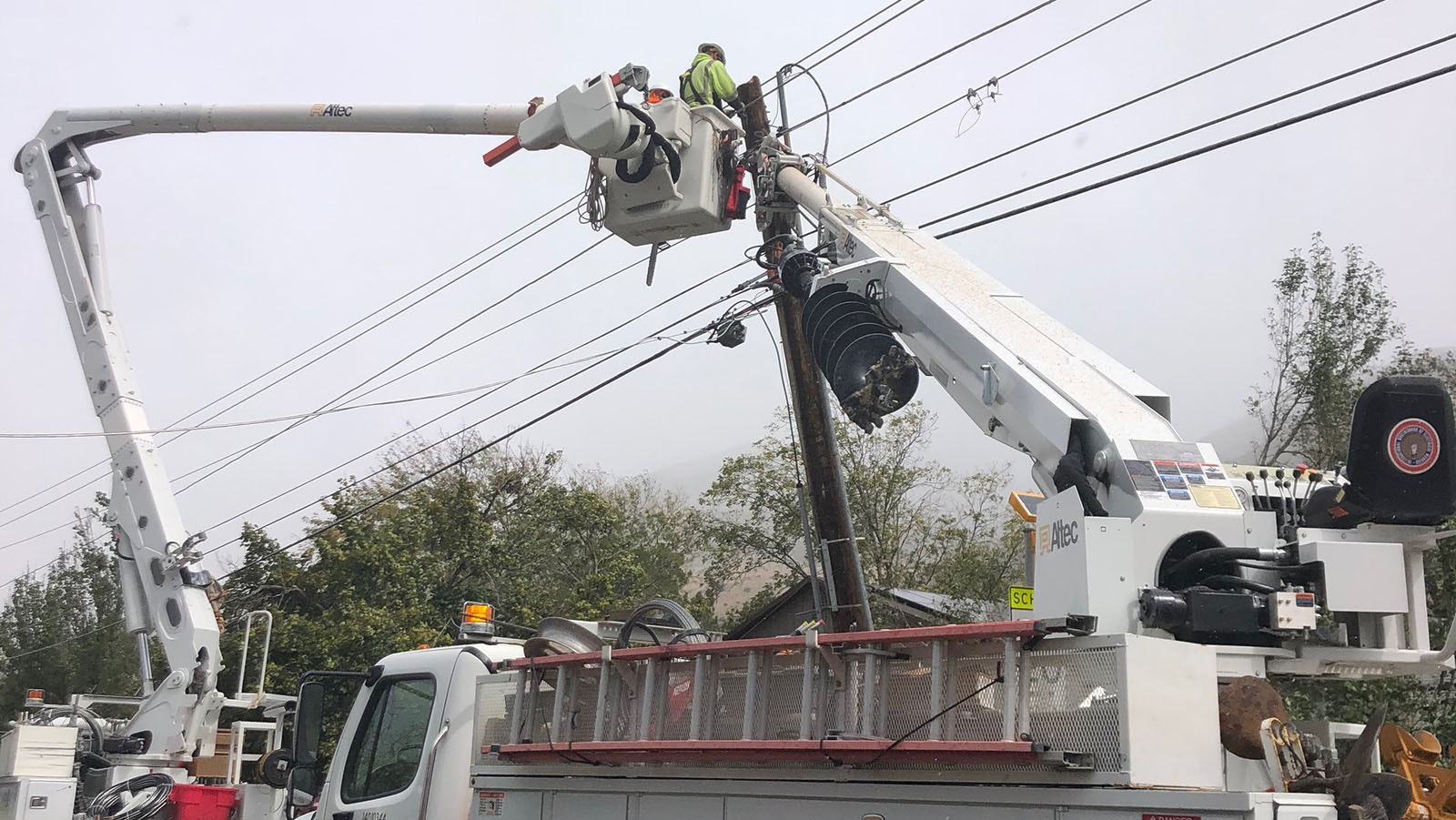LARAMIE — Dick Garlish, who was named president of Rocky Mountain Power (RMP) nearly two weeks ago, said on the sidelines of a Laramie event Tuesday that his utility’s latest request for rate hikes in Wyoming are being driven by inflation, disruptions in its market caused by a Utah coal mine fire and higher coal transportation costs.
RMP wants a Wyoming regulatory agency to permit the utility to raise electricity rates by a combined $116.3 million, or 16.5%, on all of Wyoming’s 144,511 customers. That decision could come as early as this spring.
That’s in addition to an 8.3% increase that went into effect Jan 1. The company had initially requested more than 21%.
Garlish told Cowboy State Daily at Tuesday’s informational workshop to explain to customers why his utility has requested a double-digit rate hike that inflation is the "biggest factor.”
Inflation had hit as high as 9% in June 2022, before falling to 3.4% for the year period ending in April 2024, the Labor Department announced Wednesday.
Other RMP workshops are planned in Rawlins for Wednesday, Riverton on Thursday, Rock Springs on Friday and Cody on May 28.
In the brief interview with Cowboy State Daily, Garlish likened the rate hike request submitted to the Wyoming Public Service Commission in April to what can happen with a mortgage.
“Simply, one way to think about it is a mortgage, where there is an escrow account to hold taxes and insurance, and it goes up and down based on the value of the land,” Garlish said.
The same metaphorical example has happened with electricity costs, as they fluctuated based on factors such as supply and demand of coal, and taking on more expensive coal supply contracts for some power plants because of unexpected mine closures in Utah last year.
It’s All In The Formula
RMP, which is owned by the Berkshire Hathaway-backed PacifiCorp based in Portland, Oregon, has stated that the requested rate increases are calculated as part of their annual true-up of fuel costs.
These true-ups are based on a complicated formula involving what the company pays for fuel to burn in power plants, and what they are permitted by regulators to charge customers. The fuel prices fluctuate on an annual basis, which is why utility bills can rise or fall.
Besides inflation impacting the cost of doing business, Garlish said that the rate hike is attributed to coal and fuel supply chain disruptions.
Historically low coal inventories prompted many utilities, including RMP, to increase natural gas generation and buy more wholesale electricity while restocking depleted coal inventories.
In many coal basins nationally, coal pricing more than doubled in 2022 and remained high into 2023.
This effect on coal pricing was made worse by the war in Ukraine, when many U.S. mines, including those in Utah and Colorado, rushed to take advantage of high coal prices by exporting coal to Europe.
The depleted coal supplies worsened when the Lila Canyon underground mine near Price, Utah, which is operated by Emery County Coal Resources, a unit of American Consolidated Natural Resources, suffered a fire in September 2022, according to Garlish.
The mine, which has been unable to recover from the fire, laid off the workforce earlier this year.
In 2021, Lila Canyon produced nearly 3.5 million tons. Most of the coal was consumed by the Hunter and Huntington power plants in Utah, Garlish said.

Power Savings
Hank Kobulnick, a former pilot with United Airlines who moved from Chicago to Laramie to be closer to family, attended the workshop to see if RMP could offer any electricity savings for his church, United Presbyterian.
“We put in a new furnace and LED lights,” said Kobulnick, who said RMP helped defray some of the costs in making these purchases. “I’m just looking for ways to save on energy costs.
“If rates go up, I understand why, but there are ways to cut down on the bills.”
He’s considering the purchase of motion detectors that turn off lights in the church as another way to save on power bills.
Ronnie Zimmerman, an engineer with RMP’s Wattsmart business program, said churches, small restaurants, schools and hotels are prime targets for his program to save on power bills and avoid rising costs.
“RMP will help with LEDs and subsidies,” said Zimmerman, pointing to customers who receive discounts through bulb purchases at Home Depot and Lowes home improvement stores that RMP helps with.
“People should care about these programs because everyone is feeling pinched,” he said. “To reduce electricity usage means to keep your bill flat.”
RMP’s latest rate hike comes on the heels of a controversial rate case last year when RMP wanted to boost everyone’s power bills by nearly 30%. Through litigation between the PSC and RMP, and following angry public hearings throughout the state, the rate increase was whittled to 8.3%, giving RMP $53.9 million.
The 8.3% increase last year, which went into effect at the beginning of 2024, came in a general rate case — which happens every few years.
The hike request filed in April is the standard energy cost adjustment that RMP does annually.
In this case, RMP wants to raise monthly power bills across the Cowboy State by 12.3%, or about $86.4 million for residential, commercial and industrial customers. The other 4.2% would be realized through a tax benefit.
On average, residential customers will see their monthly bills rise 9.3%, or about $12 per month on their utility bill if the whole increase is approved.

Hidden Costs
There are typically many complicated factors involved in determining electricity bills.
The rate hike RMP announced in April is an annual cost adjustment, which is subject to review by the PSC.
The general rate increase is different than the annual energy cost adjustment that RMP wants to recover from all customer classes beginning in July.
There are other cost pressures hitting the bills of RMP’s customers.
For instance, the 12.3% increase doesn’t include a key tax benefit that effectively lowers a customer’s bill.
That tax benefit for electricity customers contained in the Tax Cut and Jobs Act of 2017 goes away beginning July 1.
Over the past three years, customer bills included the tax benefit totaling nearly $85 million. It’ll have the effect of adding another 4.2%, or $29.9 million, to everyone’s utility bills once the tax benefit goes away.
Between the annual energy cost adjustment and the tax benefit going away, a typical residential customer using 700 kilowatt-hours of electricity per month would see their monthly bill rise $16.
Garlish told Cowboy State Daily that RMP had wanted to spread out the tax benefits for Wyoming customers over a much longer period so that it could minimize the financial disruption caused by the $85 million subsidy over a three-year period.
Before joining PacifiCorp in 2020, Garlish served as senior vice president and general counsel at Peak Reliability, a Washington-based firm that worked on reliability services and markets in the U.S. West.
Earlier in his career, he held several senior positions at Boise-based Idaho Power Co., including senior counsel, director and general manager.
Garlish also served as senior corporate counsel at Sioux Falls, South Dakota-based NorthWestern Energy Group Inc.
Overall, Garlish oversees an RMP territory of more than 1.2 million customers throughout the Cowboy State, Idaho and Utah.
Pat Maio can be reached at pat@cowboystatedaily.com.





